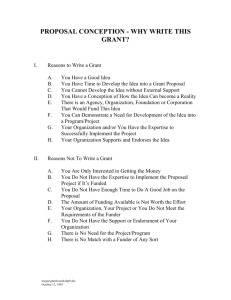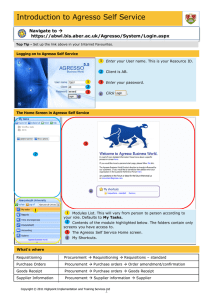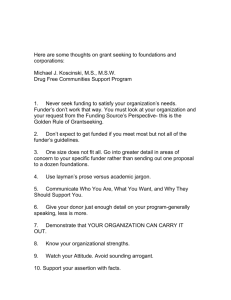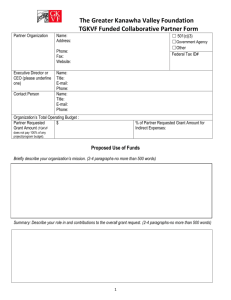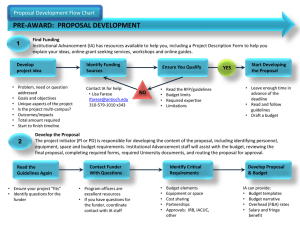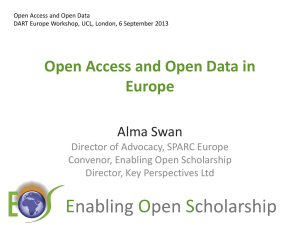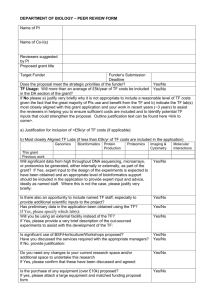CodingManual - University of the West of England
advertisement
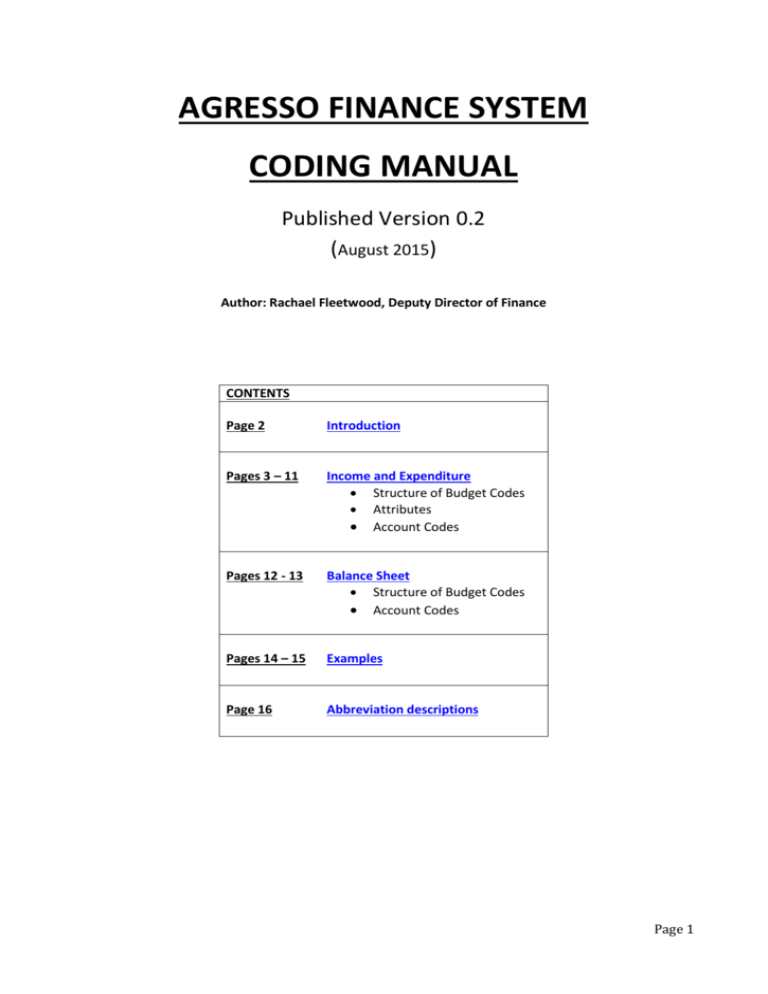
AGRESSO FINANCE SYSTEM CODING MANUAL Published Version 0.2 (August 2015) Author: Rachael Fleetwood, Deputy Director of Finance CONTENTS Page 2 Introduction Pages 3 – 11 Income and Expenditure Structure of Budget Codes Attributes Account Codes Pages 12 - 13 Balance Sheet Structure of Budget Codes Account Codes Pages 14 – 15 Examples Page 16 Abbreviation descriptions Page 1 INTRODUCTION This document contains information on the coding structure used with the University Finance System, Agresso Business World (ABW). The coding structure applies to all financial activities and the specific identification of the faculty/department/division, activity type, funding type and account code is used to: Produce management information for the multiple levels within the Organisational Hierarchy Produce the University monthly Management Accounts Produce the University Financial Statements Provide information for financial returns claims/invoices to customers and external funders Complete financial returns such as HESA, TRAC, HEBCIS Pay external agencies It is important that the activities are correctly coded in order to ensure that the University accurately reports its income and expenditure across the multiple funding streams and functions. In addition, all expenditure must be correctly coded to the Budget code that will be funding the activity to ensure that the University complies with VAT and Tax legislation and that its activities are correctly reported. CODING STRUCTURE The term Chart of Accounts simply means the collection of accounts, projects, rules and relationships that we use to define and analyse UWE’s finances. The Agresso chart of accounts structure is built around the concept of ‘Budget codes’ (previously referred to as Costcentres), ‘attributes’ and account codes. Budget Code: A budget code that holds the various transactions relevant to that activity e.g. comparable to an individual’s bank account Attribute: The most basic element of information in Agresso. They are descriptive tags that can be attached onto the Budget codes in Agresso to create more meaningful multi-dimensional reporting Account codes: Define how we analyse the products or services being bought or delivered or the type of income generated e.g. Equipment, office consumables, travel UK, advertising, telephones, photocopying When transactions are entered into Agresso, it is essential that the correct Budget code and account code are used. The budget code is the main account for the collection of income and expenditure, and the account code analyses what has been purchased; attributes are assigned to the Budget code when the code is originally set up or when additional information is required by the University. The Chart of Accounts form part of the University Financial Statements which consist of the Income and Expenditure statement, and Balance Sheet. The following 2 sections break down the coding structure between these two elements. Page 2 INCOME AND EXPENDITURE STATEMENT STRUCTURE OF BUDGET CODES Each budget code is a consistent code length and is made up of 8 Characters, (4 Alpha, 4 Numerical): A – – – U University funds R Research funds E Other external funds AAA 0000 Unit ref e.g. FIN, LAW, AEF Sequential number WHAT DO ‘U’, ‘R’ AND ‘E’ MEAN? U – University Funds This covers the normal ongoing activities of the department or division that are funded through the University by the annual budget allocation. These are commonly referred to as ‘University Funded’ and so include any core activities that: generate income (e.g. University trading activities such as Residences, Catering, Centre for Sport), are used as a ‘holding account’ for recharges to other accounts funded by the core block grant from HEFCE (includes QR but excludes HEIF as this is not deemed to be core). R - Research funds Research Accounts are established where research is undertaken for an external funder and the activity undertaken satisfies the Frascati definition of research which states: "Research and experimental development (R&D) comprise creative work undertaken on a systematic basis in order to increase the stock of knowledge, including knowledge of man, culture and society, and the use of this stock of knowledge to devise new applications." "R&D is a term covering three activities: basic research, applied research, and experimental development. Basic research is experimental or theoretical work undertaken primarily to acquire new knowledge of the underlying foundation of phenomena and observable facts, without any particular application or use in view. Applied research is also original investigation undertaken to acquire new knowledge. It is, however, directed primarily towards a specific practical aim or objective. Experimental development is systematic work, drawing on existing knowledge gained from research and/or practical experience that is directed to producing new materials, products or devices, to installing new processes, systems and services, or to improving substantially those already produced or installed." (Second chapter of the OECD 1993 Frascati Manual) Page 3 E – Other External Funds Covers any other activity that is not funded through the University annual budget or is deemed not to be research. Examples of this type of Budget code would be HEIF Funding (from HEFCE), donations from external sources, ad hoc income which is not generated year on year such as royalty income, consultancy projects, CPD activities etc. UNIT REF - AAA This refers to the 3 character reference as identified at Level 5 within the Finance Organisational Hierarchy structure. This is often a team or unit within a department or division. The latest version of the Organisational Hierarchy structure can be found here. SEQUENTIAL NUMBER Each Budget code is allocated a sequential number and is the unique code given for each Budget code. There is no meaning within this number and is purely the next number available. Page 4 ATTRIBUTES There are many attributes that can be attached to the Budget code. Ideally this is done at the point the code is created but could be added at a later stage if necessary. Attributes are used to record additional information associated with the Budget code and also provides the University with holistic, consistent and multi-dimensional reporting via the use of drop-down menus for each individual attribute. The attributes within Agresso are primarily located within various folders on the ‘Relation’ tab within the Project Master file, namely: Common Old Code Relations Data Control User Approval The following table provides a summary of the attributes which could be used against a Budget code, as well as: the Agresso Prefix for that attribute and for Activity Prefix, the reference codes a description of what the attribute (and Activity Prefix reference) means identifies whether the code is mandatory or optional and also the cost centre type to which the attribute is applicable. ATTRIBUTES USED WITHIN THE ‘COMMON’ SUB FOLDER Type Agresso Prefix Description Mandatory/ Optional Mandatory Cost Centre Code type All Activity PRO.TYPE Identifies the type of activity that the Budget code is to be used for. A few descriptions of activity types are provided below – see pages 8 & 9 Funder FUNDING Details the funding source for each activity (Please see further details regarding additional Funder attributes below) Mandatory All Budgetholder RESNO Name of the person who is accountable for the income and expenditure against each Budget code Mandatory ALL Contract Value CONT_VAL Records the contract value of externally funded projects Mandatory R & E only FIN_COST FIN_COST Used to derive the Annual Financial Statements for the University (Attribute assigned by the Group Financial Accountant) Mandatory ALL Page 5 HESA_CC HESA_CC Records Budget code against the HESA Budget code requirements. Required for external reporting requirements to HESA (As determined by the Group Financial Accountant) Mandatory ALL fEC Cost FEC_COST Identifies whether the Budget code is costed using the fEC methodology and if so, the need to ensure journal transactions are made against the account to reflect the total project cost Mandatory ALL PASS reference PASS Reference number as recorded by the PASS system Optional R & E only Corporation Tax CORP_TAX Classifies whether the Budget code is attributable to corporation tax (Attribute is assigned by the Group Financial Controller) Mandatory ALL HE-BCI Contract Type HEBCI_CONTRACT Contract type as required for HEBCI reporting purposes (Completed by the RBI team) Mandatory R & E only Master Project MASTER_PROJ Allows a number of Budget codes to be grouped together for reporting purposes Optional ALL TRAC TRAC Allocates the Budget code to the TRAC categories as defined in the drop down list – if you are unsure, please contact the TRAC Accountant Mandatory R & E only Research Centre and/or Group In-kind Contributions RESEARCH_CENTRE Assigns a Budget code to a recognised research centre or group within UWE Facility to record in-kind contributions from external organisations Optional ALL Optional R & E only Spend on Student STUDENT_SPEND To identify whether the University can use the spend incurred (excluding staff costs) to determine ‘spend on students’ for league table purposes Optional ALL IN_KIND_CONT Page 6 ATTRIBUTES USED WITHIN THE ‘OLD CODE RELATIONS’ SUB FOLDER Old Budget code OLDCOSTCTRE Enter the Old Budget code that was Optional used prior to the new code setup before 1 August 2015 (Used for historic reporting purposes) U Old UWECode OLDUWECODE Enter the UWEcode that was previously used before the Finance Organisational Hierarchy was created within Agresso (Used for historic reporting purposes) Optional ALL Allows delegated authority to approve transactions up to a certain value Optional ALL OTHER ATTRIBUTES USED User Approval FUNDER ATTRIBUTES Additional details are recorded when the Funder is initially set up to ensure holistic reporting across the University regarding where UWE receives its funds from. These are: Funder Category FUNDER_CAT Groups funders into high level categories for reporting purposes (Used as a relation from the funder details) Mandatory ALL Funder 1 and 2 Funder 1 Funder 1 % Funder 2 Funder 2 % Some projects are funded by more than one funder; details can be entered using this attribute to assign the % split from each funder Optional R & E only HE-BCI Funder type HEBCI_FUNDER Contract type as required for HEBCI reporting purposes (Completed by the RBI team) Optional R & E only Page 7 ATTRIBUTE: ACTIVITY It is important that the University records its activities correctly in order to easily complete its annual Financial Statements and other reporting requirements. The following provides a description of the activity types used against each Budget code: Activity Description Agresso Reference BS Balance Sheet Activities which relate to assets and/or liabilities such as buildings, bank accounts, stock, supplier and customer balances on accounts Conferences Conferences are usually planned several months in advance and are based on a specific event. CF Core This covers the normal ongoing activities of the department or division that are funded through the University by the annual budget allocation and is not income generating. These are commonly referred to as University Funded UC CPD/Short Courses These courses usually have a very short duration and may include Continuing Professional Development (CPD) activity. This could cover both ‘credit bearing’ and ‘non credit bearing’ courses and it is important that the correct account codes are used to determine the correct accounting treatment in the financial statements CP Donations Donations are classified as gifts to the University which are unconditional and so can be used for any purpose DO Endowment Gifts received with specific terms attached such as the need to maintain the capital sum or the capital sum can only be spent on items specified in the deed of contract (Permanent or expendable endowments). Any accounts that are set up as Endowments will be operated under the Charity Commissioner’s rules EP Holding Used for where costs are incurred and then passed onto other users e.g. salary – posted to this type of code but then recharged out to individual research projects UH Page 8 Activity Description Knowledge Transfer Partnerships (KTP) Is a part government-funded programme to encourage collaboration between businesses and universities in the United Kingdom. Each KTP involves three 'partners': Agresso Reference KP Masterplan a company (this may be a private enterprise, public body or voluntary agency), a knowledge base (in this case UWE), and an associate (a recently qualified graduate) Masterplan projects are funded from the allocated £250m capital envelope MA Other Used for ‘other’ activity not covered by one of the existing activity attributes Note: Limited use only – please speak to the Deputy Director of Finance first before using this type of activity OT Partnerships Encompasses activities such as collaborative provision, credit recognition, student exchange and any other teaching and learning activities conducted in collaboration with external institutions and organisations PA Prizes Gifts received under £25k with specific terms attached such that the interest and/or capital can be allocated as a prize, (usually annually) to students for a particular subject/course PR Refurb/Maintenance Identifies Budget codes which are used for refurb and/or maintenance activities (Primarily used by Facilities) RB Research Used for Budget codes where the activity undertaken is deemed to be for research purposes. This could involve internal and external funding streams. RX Services Rendered, Consultancy, Knowledge Exchange Funds received in return for the provision of goods or services which do not meet the research definition such as consultancy. All activity under this type of activity should still be costed under full economic costing and an appropriate price should have been agreed prior to the commencement of the work. SR Studentships Set up to support either one or more students for their ST studies, usually at postgraduate level. The funding generally covers the fees and stipend as well as providing a small non pay budget for the period of study. Page 9 Activity Description Trading Covers the normal activities of a department or division that are income generating and have income targets associated with its activities as part of the annual budget allocation. Such areas are normally within the Support functions of the University e.g. Residences, Catering, Printing & Stationery Agresso Reference UT Page 10 INCOME AND EXPENDITURE ACCOUNT CODES Account codes identify the category/type of income and expenditure being incurred and are an essential part of any transaction posting. Account codes in Agresso are 4 characters long and consist of four numbers, although the Balance Sheet codes start with a letter. Generally the first number identifies the category of income or expenditure, while the following 3 provide specific analysis. The income and expenditure account codes can be summarised as: Codes starting with: 1*** 16** 19** 2*** 3*** and 4*** 49** 5*** 76** Represents Income, including tuition fee, research, consultancy, residences and catering fEC income Internal recharge income Payroll Non Pay costs Internal recharge costs Estates/Building works account codes fEC costs On published reports direct from Agresso, the account codes have been grouped by type of category rather than showing an individual lines e.g. 4241 4242 4243 Travel (UK) Travel (EU) Travel (Overseas) ) ) Would be grouped as ‘Travel & Subsistence’ ) An end user would still have the ability to ‘drilldown’ to the individual account codes, and ultimately transactions, should they wish to do so. A full list of account codes and the respective groupings is available on the Finance webpage and can be found here. Page 11 BALANCE SHEET STRUCTURE OF BUDGET CODES Each cost centre is a consistent code length and is made up of 8 Characters, (4 Alpha, 4 Numerical): AA ZZ Balance Sheet AA 0000 Subsection of Balance Sheet FA= Fixed Asset CA= Current Asset IN = Investments DR = Debtors Sequential number within assigned block BALANCE SHEET SUBSECTIONS WITH PRE ASSIGNED NUMBER BLOCKS Blocks of sequential numbering is made available for subsections of the Balance Sheet and is as follows. ZZFA 9001 to 9100 = properties at Frenchay ZZFA 9101 to 9150 =properties at Glenside ZZFA 9150 to 9200 = properties at Bower Ashton ZZFA 9201 to 9300 = other property interests i.e. Stoke Park, Wallscourt etc. ZZIN 9301 to 9350 = Investments in subsidiaries, associates and joint ventures ZZCA 9351 TO 9599 = various current asset related cost centres i.e. stocks, loans etc. The following current asset and current liability cost centres are fixed to specific account codes for ZZDR 9400 = Debtors Ledger Control Account, operable with sub ledger only. ZZDR 9499 = Year end Journals for Debtors and Prepayments. ZZBK 9500 = all Bank Accounts ZZCR 9700 = Accounts Payable Control Account, operable with sub ledger only. ZZCR 9799 = Year end Journals for Creditors and Receipts in Advance. ZZAC 9813 to 9815 = Accommodation Deposits for specific years. Please note that all Balance Sheet Cost Centres will be set up by Financial Accounts team. For a number of other BS account codes, especially those relating to Reserves, Endowment etc, cost centre use is ZZZZ0000. Page 12 BALANCE SHEET ACCOUNT CODES The account codes used against the Balance sheet cost centres have a different structure to those within the Income and Expenditure accounts. The format for the account codes used with the Balance Sheet cost centres are 1 Alpha character followed by 3 numerical characters: A Either A or B 000 3 numbers A = Assets B = Liabilities A full list of account codes and the respective groupings is available on the Finance webpage and can be found here. Page 13 Example 1 Finance Organisational Hierarchy Structure, Cost Centres and Attributes Following example is based on the Village student accommodation at Frenchay: Level 1: University (UNIV) Level 2: Corporate Services (COPS) Level 3: Facilities (FAC) Level 4: Trading Areas (TRD) Level 5: Student Village Accommodation (STV) Cost Centres: e.g. USTV0001 Attribute: Attribute: Attribute: ACTIVITY = Trade BUDGETHOLDER = A Smith MASTER PROJECT = Accommodation Using the above we could extract reports at a cost centre level or at Level 5 for the whole of the Student Village. By using the attributes we can build information based on particular areas of commonality. For example we could produce a report on Trade activity that would include the Student Village and any other cost centres that had been tagged, has their attribute set up, as Trade activity. We could produce a set of reports for budget holder ‘A Smith’ using the Budget Holder attribute or a set of reports to cover all student accommodation (Village, Wallscourt, Cotswold Court, Glenside, etc.) using a Master Project attribute set up to capture cost centres relating to accommodation. Page 14 Example 2 ANALOGY BASED ON A DOWNLOADED MUSIC COLLECTION Level 5: Album Name Cost Centres: Tracks on the album Attributes: Artist, Type of Track (classic, hip hop, punk, etc.), person rating, etc. We could (as with the Student Village) simply call up the album by name (our standard Level 5 report) and see the individual tracks (cost centres). However by giving each track (cost centre) a number of attribute – say the name of the artist, or the type of music, or a personal rating – we are able to look at our whole music collection (Agresso database) to create a whole new set of music playlists (reports) based on the name of the particular artist or our top rated tracks or by the type of music. Page 15 ABBREVIATIONS CPD Continuing Professional Development People maintain their knowledge and skills related to their professional lives fEC Full Economic Cost The total cost of undertaking an activity including buildings, facilities, staff, consumables HEBCIS Higher Education and Community Interaction Survey Is a survey conducted by HESA which collects financial and output data for each academic year. HEBCIS is compulsory for HEIs within the UK and augments the Finance Statistics Return (FSR). Data is submitted to HESA in December of each year. HEFCE Higher Education Funding Council Promotes and funds teaching and research in higher education institutions. Includes general information and sections on finance, good practice, and research HEIF Higher Education Innovation Fund Funding provided by HEFCE to support and develop a broad range of knowledge-based interactions between Universities and Colleges and the wider world, which result in economic and social benefit to the UK. HESA Higher Education Statistics Agency Is the central source for the collection and dissemination of statistics about publicly funded UK higher education QR Quality Research Type of Funding provided by HEFCE for research performance. It is intended to strengthen and support a world class research base in English higher education institutions TRAC Transparent Approach to Costing An approach to demonstrate the full costs of research and other publicly funded activities in higher education to improve the accountability for the use of public funds UWE University of the West of England VAT Value Added Tax A tax on goods and services, which may be exempt, zero rated or standard rated. Page 16

